Dividing Fractions
- Introduction to Dividing Fractions
- Understanding Dividing Fractions – Explanation
- Dividing Fractions Using the Inverse Operation – Example
- Dividing Fractions Using the Inverse Operation – Practice
- Dividing Fractions Using the Inverse Operation – Summary
- Dividing Fractions Using the Inverse Operation – Frequently Asked Questions
Learning text on the topic Dividing Fractions
Introduction to Dividing Fractions
Dividing fractions may seem complex at first, but with the right technique, it becomes a straightforward process. By employing the inverse operation—a clever strategy that transforms division into multiplication—students can conquer fraction division with ease.
Understanding Dividing Fractions – Explanation
Division is typically one of the four basic operations in arithmetic, but when it comes to fractions, we use a method called the inverse operation.
The inverse operation for dividing fractions involves flipping the second fraction (known as finding the reciprocal) and changing the division sign to a multiplication sign.
The reciprocal of a fraction is simply swapping its numerator and denominator. So, for instance, the reciprocal of $\frac{3}{4}$ is $\frac{4}{3}$. By multiplying the first fraction by this reciprocal, we achieve the same result as division.
| Fraction | Reciprocal |
|---|---|
| $\frac{4}{5}$ | $\frac{5}{4}$ |
| $\frac{1}{6}$ | $6$ |
| $8$ | $\frac{1}{8}$ |
| $\frac{1}{2}$ | $2$ |
| $\frac{2}{3}$ | $\frac{3}{2}$ |
Dividing Fractions Using the Inverse Operation – Example
Let's look at a simple example to demonstrate how this method works in action.
Divide $\frac{3}{5}$ by $\frac{2}{7}$.
First, we identify the reciprocal of the second fraction, $\frac{2}{7}$. The reciprocal is $\frac{7}{2}$.
Now, we multiply the first fraction by this reciprocal:
$\frac{3}{5} \times \frac{7}{2} = \frac{21}{10}$
The result simplifies to $2 \frac{1}{10}$, which is our final answer.
Dividing Fractions Using the Inverse Operation – Practice
Now, let's solve another problem together.
Let's put your understanding to the test with some independent practice.8
Dividing Fractions Using the Inverse Operation – Summary
Key Learnings from this Text:
- To divide fractions, we use the inverse operation which involves finding the reciprocal of the second fraction and then multiplying.
- The reciprocal of a fraction is obtained by switching its numerator and denominator.
- After multiplying, always simplify the result to its lowest terms.
- An easy way to remember how to divide fractions is to think K.F.C (Keep, Flip, Change).
Continue practising with a variety of problems including multiplying fractions to strengthen your understanding of dividing fractions using the inverse operation. Explore other content, such as interactive practice problems and printable worksheets, to enhance your learning experience.
Dividing Fractions Using the Inverse Operation – Frequently Asked Questions
Dividing Fractions exercise
-
Find the reciprocal.
HintsTo find the reciprocal of a fraction swap the numerator and denominator, i.e. the reciprocal of $\frac{6}{7}$ is $\frac{7}{6}$.
The reciprocal of a unit fraction is a whole number. For example, the reciprocal of $\frac{1}{6}$ is $6$.
The reciprocal of a whole number is a unit fraction. For example, the reciprocal of $2$ is $\frac{1}{2}$.
SolutionThe reciprocal of $\frac{2}{3}$ is $\bf{\frac{3}{2}}$.
The reciprocal of $\frac{4}{5}$ is $\bf{\frac{5}{4}}$.
The reciprocal of $3$ is $\bf{\frac{1}{3}}$.
The reciprocal of $\frac{7}{2}$ is $\bf{\frac{2}{7}}$.
The reciprocal of $\frac{1}{4}$ is $\bf{4}$.
-
Use the inverse operation to solve the division questions.
HintsThe inverse of multiplication is division.
Remember to use the reciprocal (swap the numerator and denominator). For example, the reciprocal of $\frac{3}{8}$ is $\frac{8}{3}$.
For example:
$\frac{2}{7} \div \frac{3}{4} = \frac{2}{7} \times \frac{4}{3} = \frac{8}{21}$
Solution$\frac{2}{5} \div \frac{1}{4} = \frac{2}{5} \bf{\times \frac{4}{1}}$ $= \frac{8}{5}$
${}$
$\frac{5}{6} \div \frac{2}{7} = \frac{5}{6} \bf{\times \frac{7}{2}}$ $= \frac{35}{12}$
${}$
$\frac{3}{4} \div \frac{5}{3} = \frac{3}{4} \bf{\times \frac{3}{5}}$ $= \frac{9}{20}$
${}$
$\frac{4}{7} \div 5 = \frac{4}{7} \bf{\times \frac{1}{5}}$ $= \frac{4}{35}$
${}$
$8 \div \frac{3}{5} = 8 \bf{\times \frac{5}{3}}$ $=\frac{40}{3}$
-
What is $\frac{2}{5} \div \frac{4}{9}$?
HintsMultiply the first fraction by the reciprocal of the second fraction.
We can also say use the inverse operation - swap the numerator and denominator and multiply.
For example, $\frac{3}{8} \div \frac{5}{4} = \frac{3}{8} \times \frac{4}{5}$
There are two correct answers, one is simplified and the other is unsimplified.
For example, hint two has two possible answers.
$\frac{3}{8} \div \frac{5}{4} = \frac{3}{8} \times \frac{4}{5} = \bf{\frac{12}{40}}$ or $\bf{\frac{3}{10}}$
Solution$\frac{2}{5} \div \frac{4}{9}$
$= \frac{2}{5} \times \frac{9}{4}$
$= \bf{\frac{18}{20}} = \bf{\frac{9}{10}}$
-
Divide the fractions.
HintsThe reciprocal of a unit fraction is a whole number. For example, the reciprocal of $\frac{1}{6}$ is $6$.
The reciprocal of a whole number is a unit fraction. For example, the reciprocal of $2$ is $\frac{1}{2}$.
Remember when multiplying a fraction by a whole number we only multiply the numerator. For example, $\frac{2}{3} \times 4 = \frac{8}{3}$.
Solution$\frac{3}{8} \div \frac{2}{5} = \frac{3}{8} \times \frac{5}{2} =$ $\bf{\frac{15}{16}}$
$\frac{3}{4} \div 5 = \frac{3}{4} \times \frac{1}{5} =$ $\bf{\frac{3}{20}}$
$6 \div \frac{7}{2} = 6 \times \frac{2}{7} =$ $\bf{\frac{12}{7}}$
$\frac{5}{9} \div \frac{1}{4} = \frac{5}{9} \times \frac{4}{1} =$ $\bf{\frac{20}{9}}$
-
What is $\frac{2}{3} \div \frac{1}{5}$?
HintsMultiply the first fraction by the reciprocal of the second fraction.
To find the reciprocal swap the numerator and denominator. For example, the reciprocal of $\frac{3}{8}$ is $\frac{8}{3}$.
An example:
$\frac{3}{4} \div \frac{2}{3} = \frac{3}{4} \times \frac{3}{2} = \frac{9}{8}$.
Solution$\frac{2}{3} \div \frac{1}{5} = \frac{2}{3} \times \frac{5}{1} = \frac{10}{3}$
-
What is $\frac{5}{6} \div \frac{5}{9}$?
HintsMultiply the first fraction by the reciprocal of the second fraction.
Simplify your answer before converting it to a mixed number.
A mixed number has a whole number part and a fractional part, i.e. $3 \frac{2}{5}$.
Solution$\frac{5}{6} \div \frac{5}{9} = \frac{5}{6} \times \frac{9}{5} = \frac{45}{30} = \frac{3}{2} = 1\frac{1}{2}$
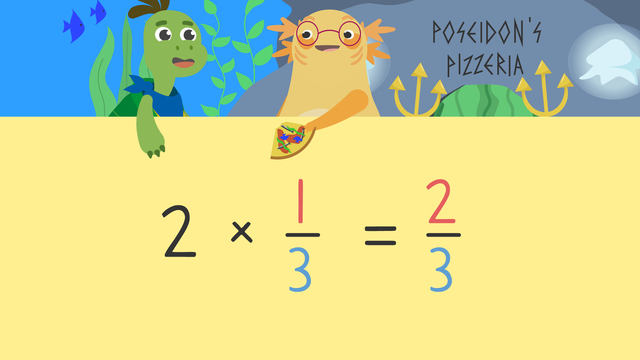
Fractions as a Multiple of Unit Fractions
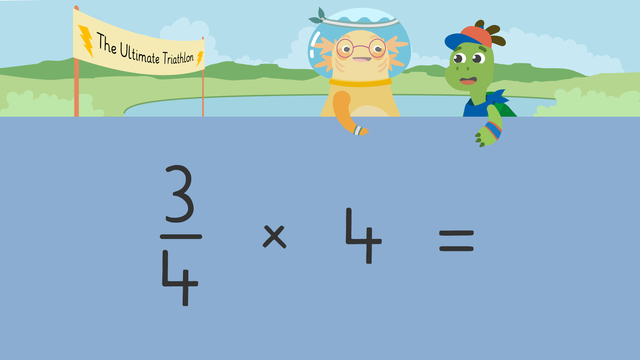
Multiplying a Fraction by a Whole Number

Multiplying Fractions Less Than One
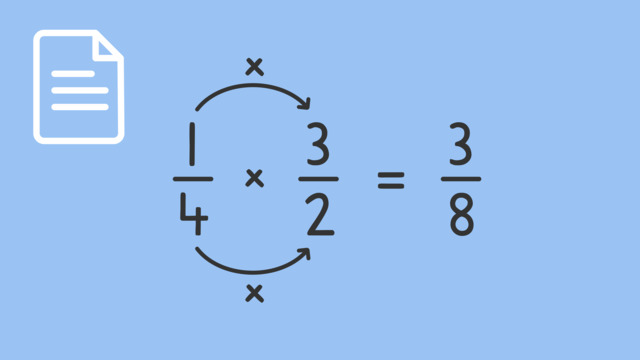
Multiplying Fractions

Dividing Fractions
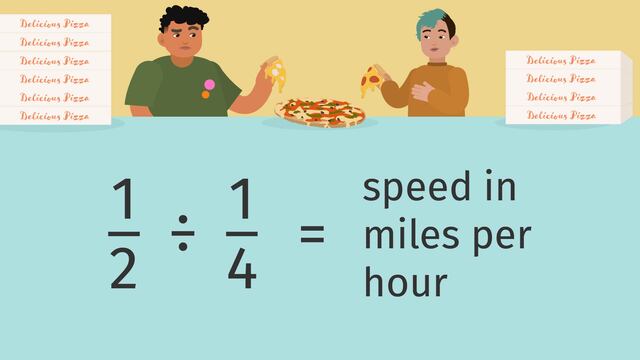
Ratios of Fractions
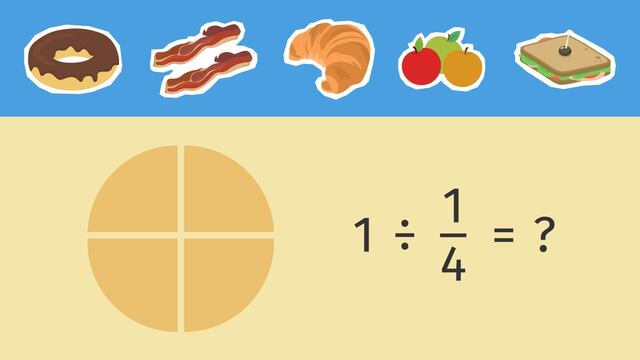
Dividing Whole Numbers by Unit Fractions Using Models
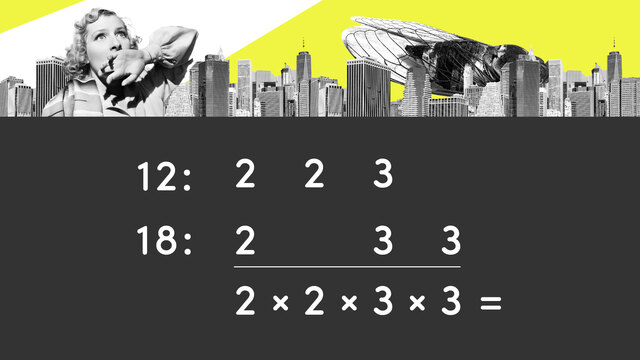
Lowest Common Multiples
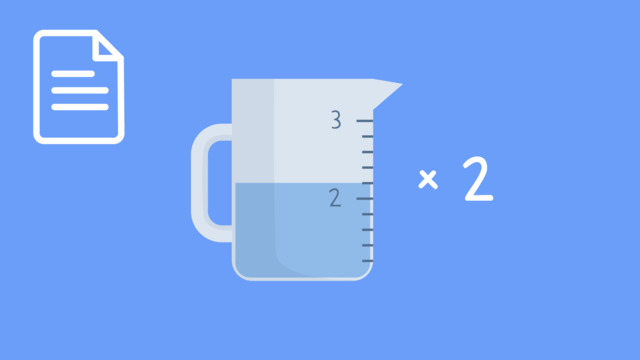
Multiplying Mixed Numbers: Word Problems

Finding the Greatest Common Factor
 Do you want to learn faster and more easily?
Do you want to learn faster and more easily?










